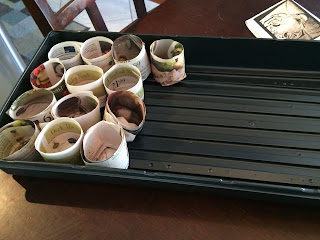Getting the Garden Ready
I love all the information available on the internet to help me decipher when to plant or overcome any issue, major or minor, that I could ever possibly encounter.
I checked this site, and the site gave me a great snap shot of my microclimate:
|
I would like to plant out sometime in late March, so I thought I would get started with germinating and starting some seeds.
On a field trip in Seattle to Oxbow Farms with my son, we were introduced to this nifty tool.
You can find the tool here.
You can find the tool here.
This is my first year using it to start seeds with newspaper.
Here's the steps I used to make the seed pots.
A strip of newspaper….
Fold in the edges and smash it into the the base.
Ta da…
Next I filled them with compost and potting soil. I love this brand called "black cow." My local home improvement store didn't have "black cow," but they did have "black chicken." Black chicken was very stinky!
All full!
I start my seeds in zip lock bags on a damp paper bowl.
I did this and as they germinated I translated them to my seed pots.
We are getting a good start. I am using a squirt bottle to water them, and I'm impressed with how well the newspaper is holding up. I thought they might be falling apart by now, but I think they are going to be perfect for translating…decomposing enough to keep the roots from forming a root ball instead of spreading out into the garden soil. I did add a little bit of the compost to the bottom of the seed pots, that I am hoping will provide fertilizer for the plants until they are planted out. I'm unsure if I will have too much nitrogen in the soil for some plants…. we will see. So far, I'm happy.
I have had some cardboard boxes in the back of the truck, which has kept me from getting a scoop of garden soil for my bulk dealer. I'm hoping to empty my compost container into the bottom of my raised bed, even if it isn't completely finished and then add lots of garden soil to the top.


















